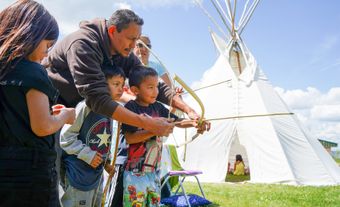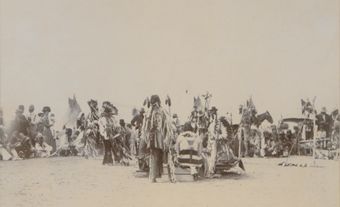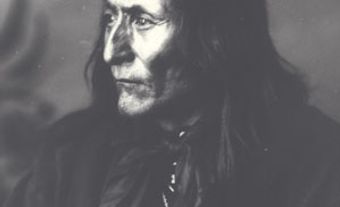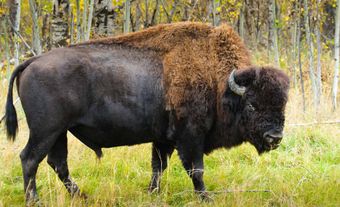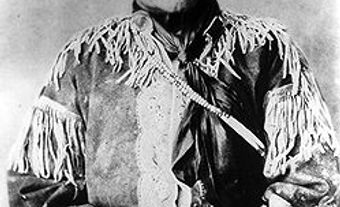The Kainai (G-ai-nah) Nation, otherwise known as the Blood Tribe, is a First Nation based in southern Alberta. Kainai Nation holds two reserves, Blood 148 and Blood 148A. Blood 148, the nation’s primary reserve, is the largest First Nation reserve by area in Canada. It covers 1,342.9 km², and is located southwest of the city of Lethbridge, north of the town of Cardston, and east of Pincher Creek. The nation’s second reserve is known as a “timber limit” and is used for hunting and fishing. As of 2021, there are 8,517 people living on the primary reserve, making it one of the most populous reserves in Canada. In total, Kainai Nation has 12,738 registered band members. (See also Reserves in Alberta.)
The Kainai Nation is a signatory to Treaty 7. Mi’k ai’stoowa (Red Crow) signed on behalf of the nation in 1877. ( See also History of Kainai Nation (Blood Tribe).)
History
The Kainai, as part of the Blackfoot Confederacy, had territory which stretched from the Rocky Mountains in the west to the Great Sandhills, in present-day Saskatchewan, in the east. The territory was bound by the North Saskatchewan River in the north and the Yellowstone River, in present-day Montana, in the south.
The Kainai are believed to have been placed on this territory by the Creator, Napi. They were a nomadic people who hunted buffalo as their primary means of sustenance. As Prairie people the Blackfoot warred constantly with neighbouring nations, notably the Cree.
The Kainai organize history into seven periods. The current historical period is referred to as i’kookaikski, Blackfoot for “the age when the people used tipi designs.” This period stretches back 500 years, and includes the transition from pre-contact life, through the signing of Treaty 7, and into modern times.
According to Hudson’s Bay Company records, the Blackfoot first encountered traders in 1691, which led to a phase of trade and settlement in the Blackfoot territories. Settlement and the expansion of trading networks led to an overhunting of buffalo herds. This overhunting coincided with several difficult winters. Among these winters was the otsistsi pakssaisstoyiih pi, or “the year when the winter was open and cold.” In addition, the North-West Mounted Police arrived in the West in 1874, promoting further colonization of Blackfoot territories by non-Indigenous settlers. These factors contributed to the Kainai choosing to sign peace treaties. (See alsoHistory of Kainai Nation (Blood Tribe).)
Treaty 7
(courtesy Native Land Digital / Native-Land.ca)
In 1877, Mi’k ai’stoowa (Red Crow) signed Treaty 7. Mi’k ai’stoowa was clan leader of the Mamio-yiksi (Fish Eaters Clan) and chief of the Kainai. Red Crow learned much of his treaty negotiation skills from his uncle Piinakkoyim (Seen From Afar). In 1855, Piinakkoyim had negotiated Otahkoi iitahtaa, or the Lame Bull Treaty, with the United States government.
The signing of Treaty 7 dramatically altered life for the Kainai. The treaty was signed in order to offer benefits to the Blood Tribe. These benefits were meant to include access to education, health care, and economic development. Mi’k ai’stoowa negotiated that the Blood Tribe would live in the area traditionally known as the Belly Buttes. Today, this is where the Kainai Nation’s reserves are located.
Following the settlement of the reserve, the Kainai were bound by the Indian Act, which, among other conditions, imposed the pass system and residential schools on the nation.
Land Claims and Other Settlements
Over the years, the Kainai Nation has filed several specific claims with the federal government. The specific claims process, introduced in 1973, addresses the grievances of First Nations who signed treaties but did not receive what they were entitled to.
For example, the Kainai Nation settled a cattle claim with the Canadian government in July 2019. The claim deals with the government’s mismanagement of the nation’s cattle between 1894 and 1923. The settlement provided $150 million to the reserve. Of that amount, $27 million was designated for distribution to band membership, and the remaining $123 million for housing projects, capital works, and recreation facilities, including a new hockey rink.
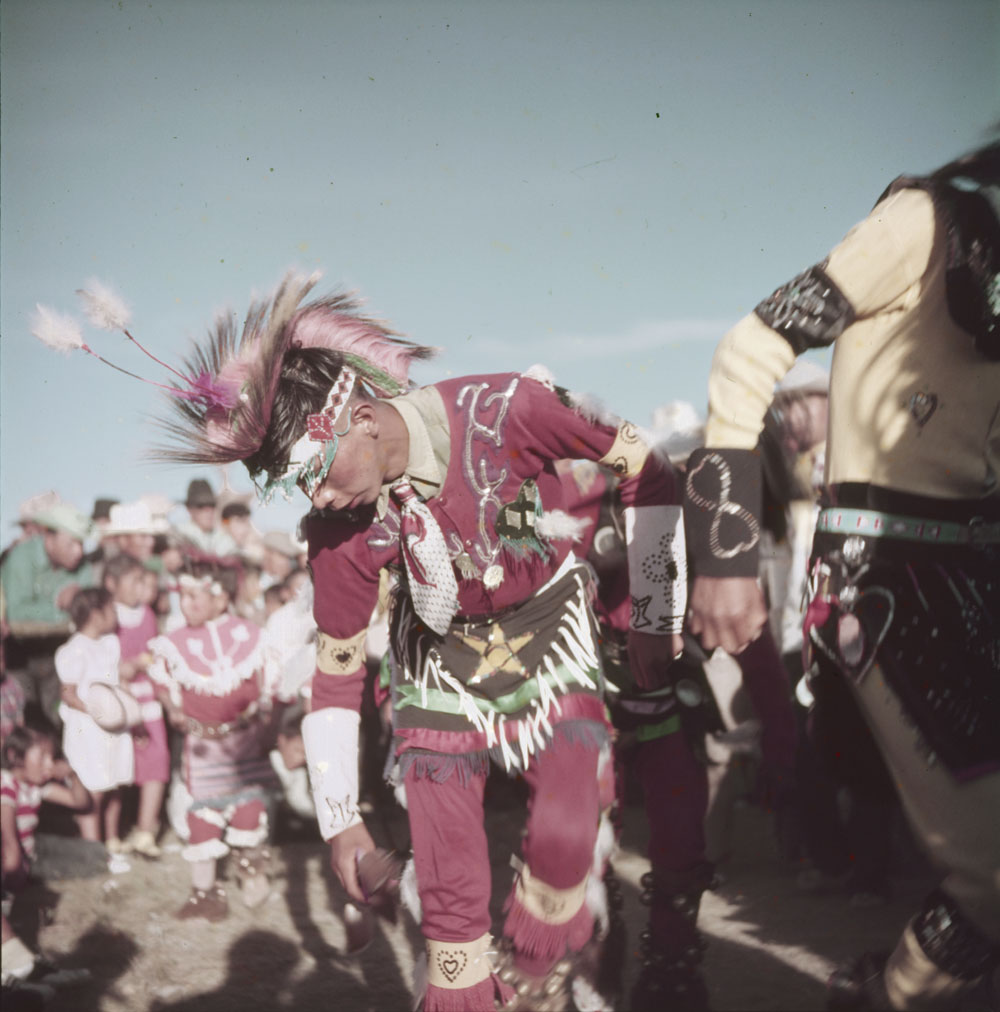
The Kainai Nation is also currently in court to discuss compensation for “The Big Claim.” The Big Claim is a land claim originally launched in 1980. In 2019, a Federal Court judge found that the Blood Tribe was entitled to 1,838 km2 of reserve land under Treaty 7. However, Canada failed to fulfill this obligation. The court ruled the nation was owed an additional 420 km2 of reserve land.
Governance
The Kainai Nation is part of the larger Blackfoot Confederacy, along with the Piikani and Siksika nations. Leadership and power is diffused in a non-hierarchal system, and splintered through a complex governing system. The Kainai Nation (and the Confederacy as a whole) is governed by a broad network of different clans and honour (or warrior) societies. Blackfoot societies include the Horn, Tail and Bull societies, among others. As part of the Blackfoot governing model, each society maintains a specific responsibility and function within the nation. For example, the Horn Society is responsible for leading certain cultural and spiritual practices.
Outside of the society model, the Kainai Nation also maintains a system of clans. Clans are based on kinship. Examples of Kainai clans include the Many Ghosts Clan, the All Tall People Clan, the Fish Eaters Clan and the Small Blanket Clan.
In terms of modern governance, the nation is governed by an elected chief and council (made up of up to 12 councillors) for four year terms. The Kainai Nation is currently led by Chief Roy Fox (Makiinima). Fox was most recently elected in 2016, but also served as chief through the 1970’s and 1980’s.
Arts and Culture
The Kainai Nation is home to a number of prominent actors, filmmakers and athletes. Actor Eugene Brave Rock, who grew up on the reserve, is known for his role in the DC Comics movie Wonder Woman. Actress and film maker Elle-Máijá Tailfeathers has received accolades for her work on films like The Body Remembers (When the World Broke Open) and Blood Quantum.

Athlete Joy SpearChief-Morris is also a member of Kainai Nation. SpearChief-Morris represents Canada at international track competitions, and will represent Canada in the rescheduled 2020 Summer Olympics.
The Kainai Nation also has a history of competing in rodeo. For example, Tom Three Persons was known for his prowess in saddle bronc competitions. Three Persons won the saddle bronc competition at the 1912 Calgary Stampede, and was inducted into the Canadian Pro Rodeo Hall of Fame in 1983.

 Share on Facebook
Share on Facebook Share on X
Share on X Share by Email
Share by Email Share on Google Classroom
Share on Google Classroom
